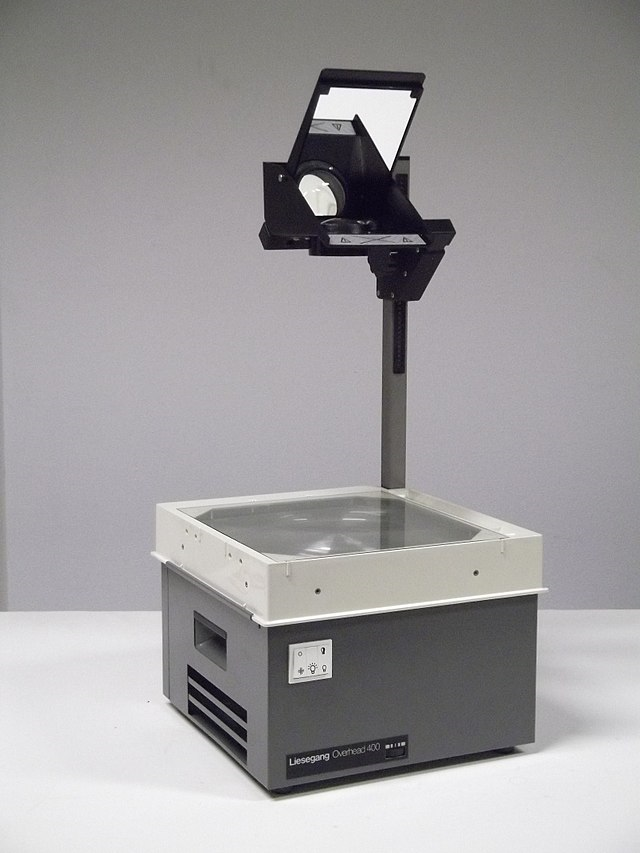My last post looked forwards, considering what next, so it seemed natural to also do a little bit of reflection. I have now been involved in schools, including my teacher training, for around 26years. In that time I have seen a number of technology items come and go.
1990s
I went through my teacher training in the mid-90s working as a “technology” teacher in departments where craft and design was still the most significant part of the taught curriculum. Overhead projectors were still widely in use as were the traditional chalk whiteboard. I remember on many occasions arriving home to find the left hand side of my suit covered in chalk dust from where I had brushed the board while writing on it.

During my teacher training, I took a laptop and LCD panel into a school I was attending as a trainee teacher; The panel was basically an LCD matrix, which fitted over a conventional OHP, allowing the OHP to provide the light which then projected the LCD image onto a wall or pull down screen. I was using the unit to display a little 3D animation I had created for a lesson on orthographic projection. The hope was the little animation of a 3D object would help students visualise the 3, 2D projection planes. For me this panel was the precursor for the common data projector now seen in classrooms everywhere.
2000s
The start of the 2000s saw me now teaching Computing/IT in an FE college. Data projectors were now much more common, and from what I can remember, were available in each of the Computing/IT classrooms. It was at this point the Interactive Whiteboard seemed to start to make an appearance. My first experience was of Promethean whiteboards and the often lost pen which came with them, an expensive item for schools given the loss rate. I need to admit to being quite eager in the use of IWBs back then; They were an infrastructure item which was dealt with by the IT Services department so all I saw was their potential, and not the cost; Who would fail to be positive about a new technology item with an apparent zero cost. It would be later in my career where I started to consider cost vs. benefit of IWBs and develop a less than positive view of them.
Around the same time there was a big push on all schools and colleges having a virtual learning environment. Again, I was positive about the potential at that time. I didn’t fully appreciate the amount of time that would be taken creating and keeping content up to date, plus the tendency for VLEs to simply end up as a dumping ground for worksheets. I will however note, the VLE did start to push the boundaries in terms of where learning could take place, suddenly allowing students to access learning resources provided by their teachers at any time and in any place, or at least any place with internet access.
Laptops for teachers came and went during this period. It was great when the funding was available as schools bought their staff nice new laptops which helped in preparing resources, marking, record keeping, etc. The issue was to come 3 or 4 years later as laptops reached the end of their lifespan yet the funding to replace them no longer existed.

Gaming was also something I got involved in back in the 2000s, introducing cross college gaming competitions initially using some Xboxes, then Xbox 360’s and latterly on PCs with the Halo series of games being particularly popular. As I returned to secondary education, my teachers desk drawer hid a PlayStation 2, connected to my classroom projector, while most of the PCs had a number of strategy games such as Age of Empire on them for LAN gaming after school hours.
It was at this time I made an attempt at paperless assessment. As a visiting moderator I was astounded at the amount of paper I was presented with when moderator the BTec IT qualifications so set myself the challenge of presenting our moderator all of the evidence electronically rather than as printed copies. It did take a bit of explaining to the moderator, who like me normally would be presented by reems and reems of printed copy yet was now just presented with a CD-Rom and a PC.
2010s
The start of the 2010s saw me in the Middle East where some schools which hadnt embraced technology yet while others were in similar situations to schools in the UK. Those schools which hadnt embraced technology might have IT labs but these were often not networked and were without internet access. The schools themselves often only had a basic domestic internet service available in a limited number of areas and there were certainly no PCs or data projectors in the average classroom. For these schools, heavy investment would see the basic infrastructure put in quite quickly with training quickly following.

In the schools where technology had been embraced, the 2010’s saw the start of discussions around 1:1 devices with the iPad being a particularly favoured device. Students could now enjoy the power of technology to communicate, to collaborate, to problem solve and to be creative in their lessons, all supported by their own individual bit of technology.
Cloud based productivity suites also made their appearance in the 2010s with Google Classroom being a favourite. I myself made use of the Google suite of apps in a number of schools although when I returned to the UK in the middle of the 2010’s I then switched to the competing solution provided by Microsoft in Office 365. Office 365 quickly developed to catch up with Google, who stole the initial march in this area, with the launch of Microsoft Teams being a key moment in the development and use of Office 365 in schools and colleges.
The flipped classroom idea made an appearance; So, teachers using technology so students can do the learning at home, and then practice it in class with their teachers, rather than learning in school and practising, through homework, at home.
2020s
Its early days. A pandemic has accelerated the use of technology in schools but also highlighted the issues such as a lack of general investment in infrastructure, devices and in professional development around technology use in schools. I have already posted some thoughts for what might come next in this decade however additionally I think its worth mentioning esports and Virtual Reality. I see esports as a key area of growth in the years ahead with Virtual Reality also showing some very clear potential although I do worry that VR may go the way of the 3D projector, and be something which doesn’t quite live up to the hype or mainstream use.
Conclusion
Its interesting looking back. When I think of each decade I have clear memories of the technologies which were becoming common or trending in education. I suspect there are other technologies which I have missed from my post but these are the ones which stuck out in my memory. I also note, that maybe as I have got older I have became a bit more balanced on my views as to new technologies, whereas when I was younger my eagerness may have got the better of me.
Or maybe I am just becoming a little more cynical when speaking with Technology salespeople?

